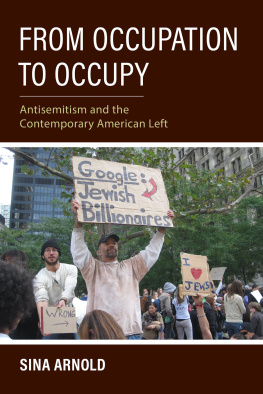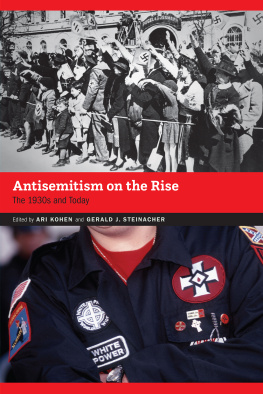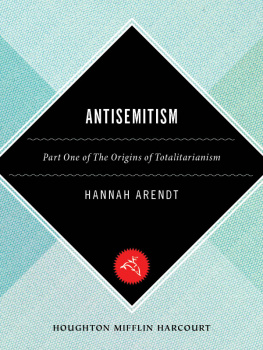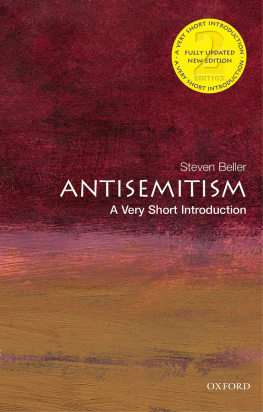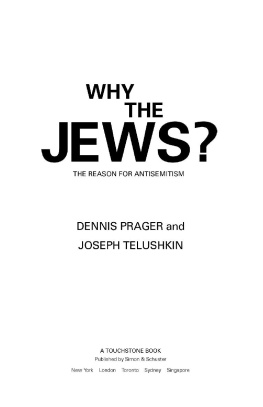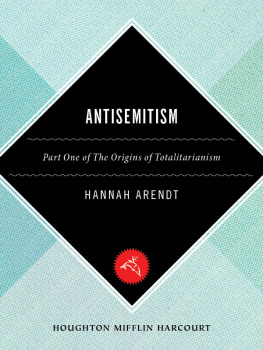A History of Antisemitism in Canada
A History of Antisemitism in Canada
IRA ROBINSON

Wilfrid Laurier University Press acknowledges the support of the Canada Council for the Arts for our publishing program. We acknowledge the financial support of the Government of Canada through the Canada Book Fund for our publishing activities. This work was supported by the Research Support Fund.

Library and Archives Canada Cataloguing in Publication
Robinson, Ira, 1951, author
A history of antisemitism in Canada / Ira Robinson.
Includes bibliographical references and index. Issued in print and electronic formats.
ISBN 978-1-77112-166-8 (paperback).ISBN 978-1-77112-168-2 (epub).
ISBN 978-1-77112-167-5 (pdf)
1. AntisemitismCanadaHistory. 2. CanadaEthnic relations. I. Title.
DS146.C2R62 2015 305.8924071 C2015-903244-X
C2015-903245-8
Cover design by Angela Booth Malleau. Front-cover photo: Christians Only restrictive signage, ca. 1938, taken probably in Quebec; Federal Photos image / Canadian Jewish Congress Charities Committee National Archives. Text design by James Leahy.
2015 Wilfrid Laurier University Press
Waterloo, Ontario, Canada
www.wlupress.wlu.ca
This book is printed on FSC certified paper and is certified Ecologo. It contains post-consumer fibre, is processed chlorine free, and is manufactured using biogas energy.
Printed in Canada
Every reasonable effort has been made to acquire permission for copyright material used in this text, and to acknowledge all such indebtedness accurately. Any errors and omissions called to the publishers attention will be corrected in future printings.
No part of this publication may be reproduced, stored in a retrieval system, or transmitted, in any form or by any means, without the prior written consent of the publisher or a licence from the Canadian Copyright Licensing Agency (Access Copyright). For an Access Copyright licence, visit http://www.accesscopyright.ca or call toll free to
1-800-893-5777.
To my grandson, Aaron Mark Epstein:
May you grow up to see a world in which
the phenomenon described in this book is
of only historical interest.
Contents
Preface
How odd of God / To choose the Jews.
Attributed to William Norman Ewer
In 1932, A.M. Klein had this to say about the phenomenon of antisemitism in Canada: Anti-Semitism in this country is a mild affair compared with the persistent and malignant forms which it assumes in some countries.
What This Book Hopes to Do
This book on antisemitism in Canada seeks to present a comprehensive, up-to-date account of the phenomenon. It builds on the foundation of numerous previous studies on antisemitism in general, and on While this book uses some archival sources, for the most part it relies on published sources, including journalistic and Internet, as well as published scholarly analysis. In this connection, I draw inspiration from the words of German historian Jrgen Osterhamel:
To know all there is to know is not the key qualification No one has sufficient knowledge to verify the correctness of each detail or to draw fully adequate conclusions from the existing body of research in countless different areas. Two other qualities are the really important ones: first, to have a feel for proportions, contradictions, and connections, as well as a sense of what may be typical and representative, and second, to maintain a humble attitude of deference toward professional research.
This book will attempt to understand the many ways in which antisemitism has impacted Canada as a whole, and will examine most especially its influence on the development of Canadas Jewish community. It will give readers interested in the phenomenon of antisemitism in Canada the tools to understand why antisemitism in general is such a controversial subject. It will acquaint them with the deep ambiguities inherent in the historical relationship between Jews and Christians and will then show them these ambiguities at play in the unfolding historical relationship between Jews and their fellow Canadians of other religions and ethnicities. It will examine present relationships in light of history and, most particularly, will consider the influence of antisemitism on the social, religious, and political history of the Canadian Jewish community.
This book presents the reader with the first full-length study of the phenomenon of antisemitism in Canada. While there are numerous books and articles devoted to various aspects of the subject, this is the first one that seeks to present a comprehensive account of antisemitism and its effect on the Jewish community of Canada. This will make it valuable to students and scholars of Canadian history, Canadian Jewish studies, Canadian ethnic studies, and antisemitism.
The Books Organization
The book is divided into four sections. The first is an introduction designed to accomplish several things. The first chapter discusses the complexities involved in any careful and nuanced definition of the term antisemitism. It then looks at the broad historical sweep of relations between Jews and non-Jews in premodern times. The second chapter examines more specifically the presence of Jews in the cultures, stories, and imaginations of the French and the English in the medieval and early modern periods. These ideas about Jews were what the first European settlers in what would become Canada brought with them from their homelands. It is these ideas that informed early reactions to the presence of Jews and Judaism in British North America.
The second section examines the interaction between Jews and other Canadians from the mid-eighteenth century to the First World War. Chapter 3 thus details the ways in which Jews and non-Jews interacted in the territories that would become the Dominion of Canada in the eighteenth and nineteenth centuries. The chapter brings the account of antisemitism up to the beginnings of the mass eastern European Jewish immigration at the turn of the twentieth century. The fourth chapter speaks of the fundamental changes that occurred in Canadian society with the simultaneous arrival in Canada of a major Jewish immigrant population and a societal discourse, imported from Europe, which brought the Jewish problem in Canada to wide public notice.
Section three speaks of antisemitism in the period between the onset of the First World War and the end of the Second World War, in which Canada greatly developed its sense of itself as a culture and polity. Chapter 5 discusses the Canadian social and institutional policies that affected relationships between Jews and non-Jews in this period. Chapter 6 examines the two major twentieth-century ideologies, communism and fascism, that greatly influenced the ways in which Canadian Jews and non-Jews related to each other in that era.
The fourth section deals with postSecond World War Canada. The discerning reader will notice a difference in the presentation because, in this relatively contemporary period, there really is much less scholarly work to go on; much of the more contemporary material is necessarily journalistic in nature. Chapter 7 discusses the postwar development of Canadian society with specific reference to changing attitudes toward Jews and alternate models for understanding who is a Canadian. These alternative models tended to be more inclusive of Jews and others. It further examines the ways in which the Canadian Jewish community was affected by these trends as well as how these trends influenced the Canadian discourse on antisemitism. Chapter 8 looks at the implications of the Holocaust for Canadian Jews, and the influence of both ongoing antisemitic manifestations and Holocaust denial on relations between Jews and non-Jews in Canada. Chapter 9 discusses the implications of the State of Israel and the IsraelArab conflict for the phenomenon of antisemitism in Canada. Finally, chapter 10 attempts to evaluate the phenomenon of antisemitism in twenty-first-century Canada.
Next page


